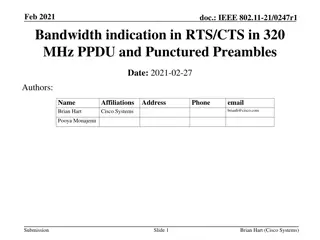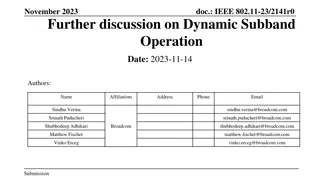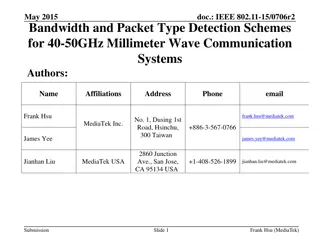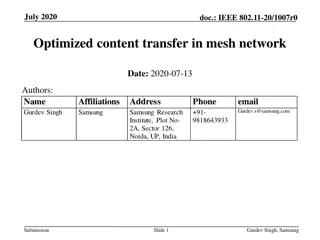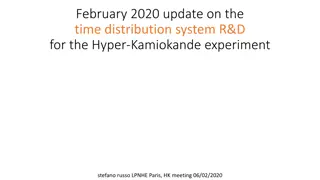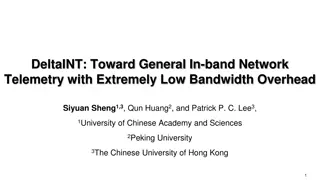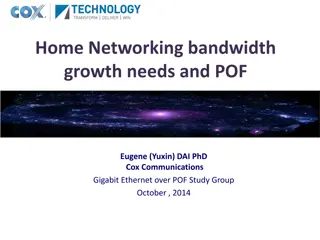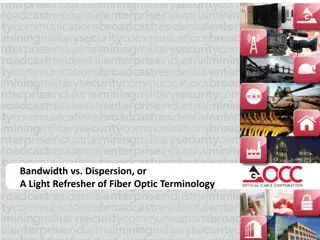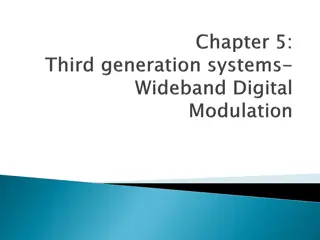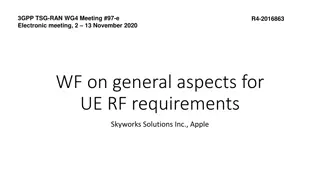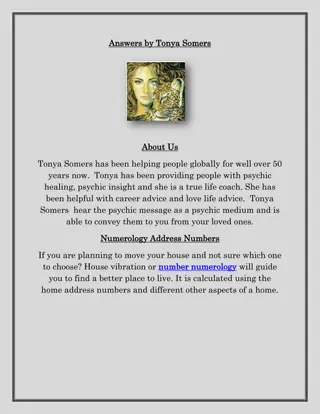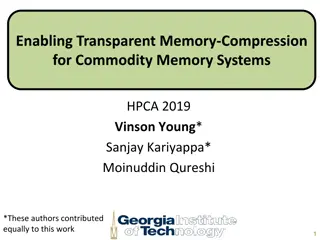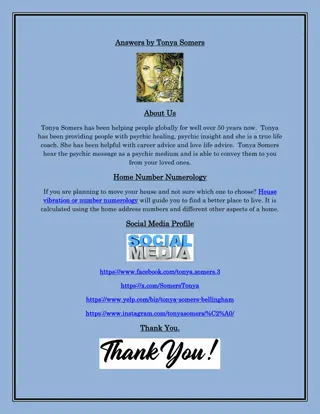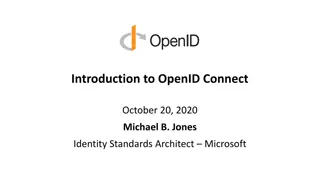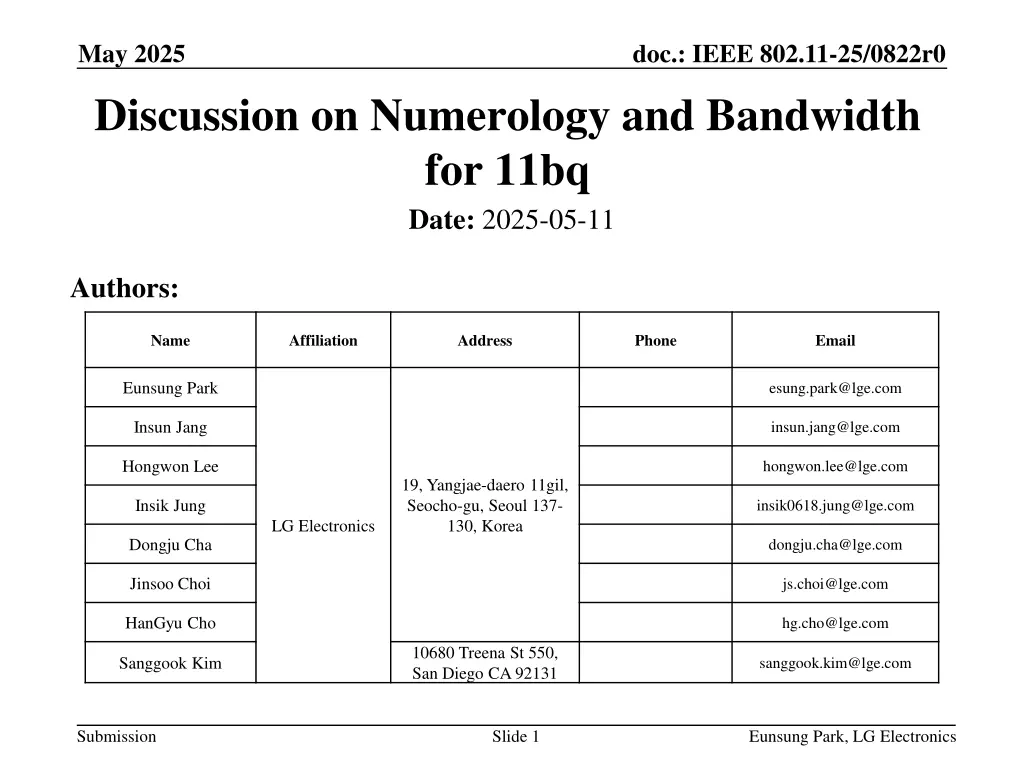
Discussion on Numerology and Bandwidth for 11bq in IEEE 802.11-25/0822r0
Explore the numerology and bandwidth considerations for 11bq in IEEE 802.11-25/0822r0, including discussions on upclocking parameters, peak data rates, implementation factors, and more. Find out how wider subcarrier spacing and upclocking parameters impact peak data rates and performance in mmWave bands.
Download Presentation

Please find below an Image/Link to download the presentation.
The content on the website is provided AS IS for your information and personal use only. It may not be sold, licensed, or shared on other websites without obtaining consent from the author. If you encounter any issues during the download, it is possible that the publisher has removed the file from their server.
You are allowed to download the files provided on this website for personal or commercial use, subject to the condition that they are used lawfully. All files are the property of their respective owners.
The content on the website is provided AS IS for your information and personal use only. It may not be sold, licensed, or shared on other websites without obtaining consent from the author.
E N D
Presentation Transcript
May 2025 doc.: IEEE 802.11-25/0822r0 Discussion on Numerology and Bandwidth for 11bq Date: 2025-05-11 Authors: Name Affiliation Address Phone Email Eunsung Park esung.park@lge.com Insun Jang insun.jang@lge.com Hongwon Lee hongwon.lee@lge.com 19, Yangjae-daero 11gil, Seocho-gu, Seoul 137- 130, Korea Insik Jung insik0618.jung@lge.com LG Electronics Dongju Cha dongju.cha@lge.com Jinsoo Choi js.choi@lge.com HanGyu Cho hg.cho@lge.com 10680 Treena St 550, San Diego CA 92131 Sanggook Kim sanggook.kim@lge.com Submission Slide 1 Eunsung Park, LG Electronics
May 2025 doc.: IEEE 802.11-25/0822r0 Introduction Many contributions discussed high level design ways and technical scope for IMMW during the SG phase [1-6] Although some of the details are slightly different, they have almost identical views Leverage the sub-7 GHz PHY design and 11be MLO architecture In this contribution, we discuss numerology and bandwidth which can be supported in 11bq To this end, we look into the following aspects Upclocking parameter 1x and 4x numerologies (i.e., ac and ax/be/bn numerologies) Possible bandwidths Submission Slide 2 Eunsung Park, LG Electronics
May 2025 doc.: IEEE 802.11-25/0822r0 Upclocking Parameter (1/2) To determine the upclocking parameter, the following factors can be taken into consideration Peak data rate Implementation Impairment factors CFO / phase noise / inter-carrier interference Delay spread / inter-symbol interference The larger the upclocking parameter is, the wider the bandwidth will be, and thus, the higher peak data rate we can achieve However, along with an increase in the upclocking parameter and the bandwidth, the hardware clock rate also needs to be faster It can be a burden on implementation Submission Slide 3 Eunsung Park, LG Electronics
May 2025 doc.: IEEE 802.11-25/0822r0 Upclocking Parameter (2/2) Based on the packet error rate results shown in [7], the upclocking parameter should be equal to or larger than 4 times Wider subcarrier spacing is more robust to CFO, inter-carrier interference, etc. However, as the upclocking parameter grows, the symbol and guard interval lengths decrease, and thus, the PPDU can become vulnerable to inter-symbol interference Many research papers cited in [8] show that, in a mmWave band, most of the delay spreads are measured within 0.1 us For a reliable performance, it may be better to have at least 0.1 us GI in a mmWave band which can be guaranteed by applying up to 8 times upclocking to 0.8 us GI We recommend 4 / 8 times upclocking 8 times upclocking may be preferable considering CFO, phase noise, etc., while 4 times upclocking may be better in terms of implementation Submission Slide 4 Eunsung Park, LG Electronics
May 2025 doc.: IEEE 802.11-25/0822r0 1x and 4x Numerologies To compare 1x and 4x numerologies (i.e., ac based and ax/be/bn based numerologies), the following factors can be taken into consideration Performance Future extension When it comes to the performance, although 1x numerology is slightly better in terms of PER, 4x numerology may be preferable given a better data rate / throughput as shown in [7] Moreover, 4x numerology can be easily expanded to advanced features such as OFDMA, higher modulation, etc., in the future, by simply reusing the existing sub-7 GHz designs We recommend to reuse 4x numerology Submission Slide 5 Eunsung Park, LG Electronics
May 2025 doc.: IEEE 802.11-25/0822r0 Possible Bandwidth (1/2) Possible bandwidths which can be supported in 11bq are investigated and we provide our thoughts on them The minimum bandwidth should be larger than (or equal to) 160 MHz In the sub-7 GHz band, bandwidths up to 80 / 160 MHz are mandatory and can be frequently used in conjunction with preamble puncturing STAs capable of a mmWave band operation may be high-end, and thus, may have a capability larger than 80 / 160 MHz The maximum bandwidth should be large enough to support various use cases of 11bq [9] although it is probably determined as an optional bandwidth considering hardware complexity The maximum bandwidth which is depending on the reused numerology and applied upclocking parameter should guarantee at least a similar level of the peak data rate supported in the sub-7 GHz band Slide 6 Submission Eunsung Park, LG Electronics
May 2025 doc.: IEEE 802.11-25/0822r0 Possible Bandwidth (2/2) Possible bandwidths for 11bq are as follows according to the upclocking parameters and numerologies 1x numerology 4x numerology Upclock. parameter 20 MHz 40 MHz 80 MHz 160 MHz 20 MHz 40 MHz 80 MHz 160 MHz 320 MHz 4 80 MHz 160 MHz 320 MHz 640 MHz 80 MHz 160 MHz 320 MHz 640 MHz 1280 MHz 8 160 MHz 320 MHz 640 MHz 1280 MHz 160 MHz 320 MHz 640 MHz 1280 MHz 2560 MHz 16 320 MHz 640 MHz 1280 MHz 2560 MHz 320 MHz 640 MHz 1280 MHz 2560 MHz 5120 MHz We recommend to define 320 MHz, 640 MHz, and 1280 MHz by applying 4 / 8 times upclocking to 4x numerology (in red) We are open to define 160 MHz and 2560 MHz (in green) 160 / 320 / 640 / 1280 / 2560 MHz can achieve about 1.4 / 2.8 / 5.7 / 11.5 / 23.0 Gbps with 64 QAM and 2 spatial streams based on the analysis in [9] A duplicated tone plan introduced in [10] is possible when using certain bandwidths (e.g., 320 / 640 / 1280 MHz based on 4 times upclocking) Slide 7 Submission Eunsung Park, LG Electronics
May 2025 doc.: IEEE 802.11-25/0822r0 Conclusion We have discussed numerology and bandwidth based on the following aspects Upclocking parameter 1x and 4x numerologies (i.e., ac and ax/be/bn) Possible bandwidths We have recommended to define 320 MHz, 640 MHz, and 1280 MHz by applying 4 / 8 times upclocking to 4x numerology We are open to define 160 MHz and 2560 MHz Submission Slide 8 Eunsung Park, LG Electronics
May 2025 doc.: IEEE 802.11-25/0822r0 Straw Poll #1 Do you support the following in 11bq? Bandwidths for 11bq are defined by applying 4 times upclocking to bandwidths defined in sub-7 GHz Whether to reuse 1x numerology (e.g., ac) or 4x numerology (e.g., ax/be/bn) is TBD Submission Slide 9 Eunsung Park, LG Electronics
May 2025 doc.: IEEE 802.11-25/0822r0 Straw Poll #1-1 Do you support the following in 11bq? Bandwidths for 11bq are defined by applying 8 times upclocking to bandwidths defined in sub-7 GHz Whether to reuse 1x numerology (e.g., ac) or 4x numerology (e.g., ax/be/bn) is TBD Submission Slide 10 Eunsung Park, LG Electronics
May 2025 doc.: IEEE 802.11-25/0822r0 Straw Poll #2 Do you support the following in 11bq? 320 MHz, 640 MHz and 1280 MHz bandwidths are defined Other bandwidths are TBD Upclocking parameter is TBD Whether to reuse 1x numerology (e.g., ac) or 4x numerology (e.g., ax/be/bn) is TBD Submission Slide 11 Eunsung Park, LG Electronics
May 2025 doc.: IEEE 802.11-25/0822r0 Straw Poll #2-1 Do you support the following in 11bq? 320 MHz and 640 MHz bandwidths are defined Other bandwidths are TBD Upclocking parameter is TBD Whether to reuse 1x numerology (e.g., ac) or 4x numerology (e.g., ax/be/bn) is TBD Submission Slide 12 Eunsung Park, LG Electronics
May 2025 doc.: IEEE 802.11-25/0822r0 Straw Poll #2-2 Do you support the following in 11bq? 320 MHz bandwidth is defined Other bandwidths are TBD Upclocking parameter is TBD Whether to reuse 1x numerology (e.g., ac) or 4x numerology (e.g., ax/be/bn) is TBD Submission Slide 13 Eunsung Park, LG Electronics
May 2025 doc.: IEEE 802.11-25/0822r0 Straw Poll #3 Do you support the following in 11bq? The smallest bandwidth for 11bq is 320 MHz Upclocking parameter is TBD Whether to reuse 1x numerology (e.g., ac) or 4x numerology (e.g., ax/be/bn) is TBD Submission Slide 14 Eunsung Park, LG Electronics
May 2025 doc.: IEEE 802.11-25/0822r0 Straw Poll #3-1 Do you support the following in 11bq? The smallest bandwidth for 11bq is 160 MHz Upclocking parameter is TBD Whether to reuse 1x numerology (e.g., ac) or 4x numerology (e.g., ax/be/bn) is TBD Submission Slide 15 Eunsung Park, LG Electronics
May 2025 doc.: IEEE 802.11-25/0822r0 Straw Poll #4 Do you support the following in 11bq? 4x numerology (e.g., ax/be/bn) is reused to define a bandwidth and a tone plan for 11bq Submission Slide 16 Eunsung Park, LG Electronics
May 2025 doc.: IEEE 802.11-25/0822r0 References [1] 11-23-1819-01-immw-integrated-mmwave-design-considerations [2] 11-23-1878-01-immw-high-level-design-considerations-of-immw [3] 11-23-1905-00-immw-high-level-thoughts-on-immw [4] 11-23-1968-00-immw-discussion-on-general-direction-of- integrated-mmwave [5] 11-23-2004-00-immw-technical-scope-proposal [6] 11-24-0066-00-immw-discussion-on-target-objectives-for-immw [7] 11-25-0854-00-00bq-considerations-on-numerology-for-immw [8] 11-22-1872-00-0uhr-considerations-on-phy-designs-for-mmwave- band [9] 11-24-0066-00-immw-discussion-on-target-objectives-for-immw [10] 11-25-0365-01-00bq-ppdu-format-for-immw Submission Slide 17 Eunsung Park, LG Electronics

